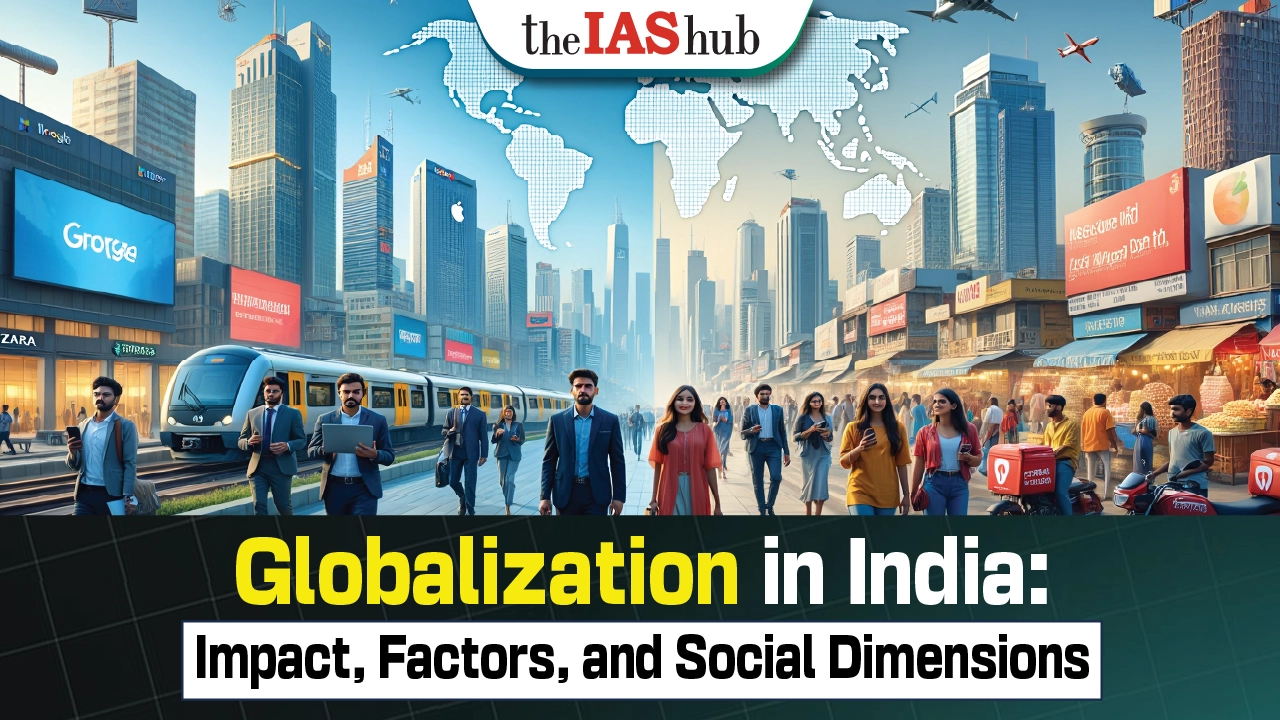Explore how globalization shaped India’s economy, culture, and society. Learn about economic reforms, FDI, cultural exchange, glocalization, and the varied impacts on women, families, and vulnerable sections in a globalized world.


Globalisation is the phenomenon of rising integration, interdependence, and interconnectedness of the global community (socially and economically).

|
Company |
Glocalization Approach |
|
McDonald's |
Adapts its menu to local tastes (McAloo Tikki in India, Teriyaki Burger in Japan) |
|
Coca-Cola |
Uses different formulas and sweeteners based on local taste preferences and health regulations |
|
IKEA |
Adapts furniture sizes to local living situations (bigger beds/kitchens in the US) |
|
Netflix |
Invests in local content production (Indian movies and series, "Money Heist" in Spain) |
|
Unilever |
Has a portfolio of local brands alongside international ones, often through acquiring local companies |
|
“India is not seeking to reverse the benefits of globalization, but is asking that it be made more transparent” - Union Finance Minister Nirmala Sitharaman |
|
Sections of Society |
Key Impacts |
Examples |
|
Children |
Exposure to global culture, influence on education |
Access to global children's content like cartoons, books, and educational platforms. Adoption of global educational practices. |
|
Youth |
Access to global education and job opportunities, influence of Western lifestyle |
More opportunities for studying abroad and working with global companies; increased consumption of global brands and entertainment. |
|
Elderly |
Impact on traditional support systems, increased exposure to global health practices |
Changes in family structure with youth moving abroad for work; access to advanced healthcare technologies and practices. |
|
Vulnerable Sections (e.g., low-income groups, marginalized communities) |
Potential exploitation, but also opportunities for empowerment |
Job displacement due to competition from global markets; but also opportunities for artisanal and traditional products to reach |
The economic and social shifts that have occurred as a direct result of globalisation are also encompassed within the definition of globalisation. Consumers in today’s world have access to a diverse array of options for both the products and services they purchase. Globalization brought positive social changes in the society; however, it becomes a point of concern when an overwhelming impact of globalisation can be observed on the Indian culture and environment.


Refine your answer writing skills and elevate your UPSC preparation with personalized support and expert feedback.
Fill out the form to get started with the program or any other enquiries !








Are you dreaming of becoming an IAS officer? Then, IAShub can be your best guide. It is one of the Best IAS Coaching in Delhi. Many students who want to clear the UPSC exam join IAShub for learning. The institute gives both online and offline classes. Their teachers are experienced and helpful. They easily explain every topic. Students also get notes, tests, and tips to do well in the exam.
IAShub is in Delhi and is trusted by many UPSC students. It offers coaching for every part of the UPSC exam – Prelims, Mains, and Interview. The classes are simple and easy to understand. The teachers are experts and guide students in the right way. IAShub is also known for its helpful notes, test series, and answer-writing practice. IAShub is the best coaching in Delhi and also gives UPSC Online Classes. This helps students from any place in India to learn. The online classes are live and also recorded. So, students can watch them anytime. These classes cover the full UPSC syllabus.
Here are some important services provided by IAShub:
The UPSC Civil Services Exam has three parts:
This exam is tough, but with the right guidance, it becomes easy to manage. Students must study smart and stay regular.
IAShub supports students from the beginning to the end. It gives the right books, tests, and notes. The classes are easy to follow, and the teachers are always ready to help. Students get personal doubt sessions too. The test series and answer checking help students learn where they need to do better. Also, free study materials save time and money.
IAShub also guides students during the final stage – the interview. Experts take mock interviews and give useful tips. This full support makes IAShub one of the best IAS coaching in Delhi.